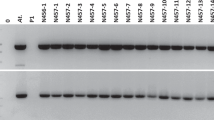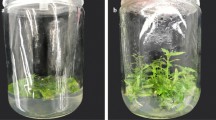Abstract
Biomass production is traditionally an important goal in forest tree breeding programs. However, progress in classical tree breeding is limited because of long generation cycles of many forest tree species. Due to this limitation, genetic engineering, and also the quite recently developed genome editing technique, are very attractive tools to improve tree characteristics in a relatively short time. As a proof-of-concept approach, the GIBBERELLIC ACID 20 OXIDASE (GA20-OXIDASE) gene was constitutively overexpressed in poplar leading to significantly higher plants. Unfortunately, deleterious side-effects were also observed, like longer and thinner shoots leading to plants with unstable stems unable to grow without external stabilization. In the literature, polyploidization was reported to increase stem thickness relatively to plant height in several plant species. Therefore, polyploidization of GA20-OXIDASE overexpressing transgenic poplar lines was attempted. Mixoploid (ploidy chimeric: diploid and tetraploid nuclei) plants were obtained and assessed for several years for ploidy status and growth performance (stem height and diameter, bud set) in climate chamber and glasshouse. The results indicate that mixoploid GA20-OXIDASE overexpressing transgenic poplar still reveal increased growth but also showed a lower height-to-stem ratio compared to the diploid GA20-OXIDASE transgenic poplar, enabling the mixoploid transgenic plants to grow without external stabilization.
Zusammenfassung
Die Biomasseproduktion ist traditionell ein wichtiges Ziel in der Forstpflanzenzüchtung. Die Fortschritte in der klassischen Forstpflanzenzüchtung sind jedoch wegen der langen Generationszyklen vieler Waldbaumarten begrenzt. Aufgrund dieser Einschränkung stellen die klassische Gentechnik sowie auch die vor kurzem entwickelte Genom-Editierung-Technik sehr attraktive Werkzeuge dar, um Eigenschaften von langlebigen Bäumen in relativ kurzer Zeit zu verbessern. Als „Proof-of-Concept“-Ansatz wurde das GIBBERELLINSÄURE 20 OXIDASE (GA20-OXIDASE) Gen in der Pappel konstitutiv überexprimiert, was zu signifikant höheren Pflanzen führte. Leider wurden auch unliebsame Nebeneffekte beobachtet, wie längere und dünnere Triebe, die zu Pflanzen mit instabilen Stämmen führen, die ohne externe Stabilisierung nicht wachsen können. In der Literatur wurde berichtet, dass die Polyploidisierung bei verschiedenen Pflanzenarten die Stammdicke relativ zur Pflanzenhöhe erhöht. Daher wurde eine Polyploidisierung von GA20-OXIDASE-überexprimierenden transgenen Pappellinien versucht. Mixoploide (ploidische Chimäre: diploide und tetraploide Kerne) Pflanzen wurden erhalten und über mehrere Jahre auf Ploidiestatus und Wachstumsleistung (Stammhöhe und -durchmesser, Knospensatz) in der Klimakammer und im Gewächshaus untersucht. Die Ergebnisse zeigen, dass die mixoploiden GA20-OXIDASE-überexprimierenden transgenen Pappeln immer noch ein erhöhtes Wachstum aufweisen, aber auch im Vergleich zu diploiden GA20-OXIDASE-transgenen Pappeln ein geringeres Verhältnis von Höhe zu Stängel zeigen, wodurch die mixoploiden transgenen Pflanzen ohne externe Stabilisierung wachsen können.




Similar content being viewed by others
References
Ahuja MR (1986) Aspen. In Evans DA, Sharp WR, Ammirato PJ (eds). Handbook of Plant Cell Culture 4, Techniques and Applications, Macmillan Publishing Company, New York, pp 626–651
Campbell MM, Brunner AM, Jones HM, Strauss SH (2003) Forestry’s f0ertile crescent: the application of biotechnology to forest trees. Plant Biotechnol J 1:141–154
Chae WB, Hong SJ, Gifford JM, Rayburn AL, Widholm JM, Juvik JA (2013) Synthetic polyploid production of Miscanthus sacchriflorus, Miscanthus sinensis and Miscanthus x giganteus. GCB Bioenergy 5:338–350
Dinus RJ, Payne P, Sewell NM, Chiang VL, Tuskan GA (2001) Genetic modification of short rotation popular wood: properties for ethanol fuel and fiber productions. CRC Crit Rev Plant Sci 20:51–69
Doblin MS, Kurek I, Jacob-Wilk D, Delmer DP (2002) Cellulose biosynthesis in plants: from genes to rosettes. Plant Cell Physiol 43:1407–1420
Dünisch O, Funada R, Nakaba S, Fladung M (2006) Influence of overexpression of a gibberellin 20-oxidase gene on the kinetics of xylem cell development in hybrid poplar (Populus tremula L. x P. tremuloides Michx.). Holzforschung 60:608–617
Edmunds CW, Peralta P, Kelley SS, Chiang VL, Sharma-Shivappa RR et al (2017) Characterization and enzymatic hydrolysis of wood from transgenic Pinus taeda engineered with syringyl lignin or reduced lignin content. Cellulose 24:1901–1914
Eriksson ME, Israelsson M, Olsson O, Moritz T (2000) Increased gibberellin biosynthesis in transgenic trees promotes growth, biomass production and xylem fiber length. Nat Biotechnol 18:784–788
Ewald D, Ulrich K, Naujoks G, Schröder MB (2009) Induction of tetraploid poplar and black locust plants using colchicine: chloroplast number as an early marker for selecting polyploids in vitro. Plant Cell Tissue Organ Cult 99:353–357
Flachowsky H, Hanke MV, Peil A, Strauss SH, Fladung M (2009) A review on transgenic approaches to accelerate breeding of woody plants. Plant Breed 128:217–226
Fladung M (2006) Modification of cellulose. In: Fladung M, Ewald D (eds) Tree transgenesis—recent developments. Springer, Berlin, Heidelberg, New York, pp 123–136
Fladung M (2013) Efficient in vitro plantlet regeneration in Populus euphratica Oliver. Afr J Biotechnol 12:826–832
Fladung M (2016) Neue Methoden der Pflanzenzüchtung: Biotechnologie 3.0. AFZ-DerWald 23/2016:48–52
Fladung M, Muhs HJ, Ahuja MR (1996) Morphological changes observed in transgenic Populus carrying the rolC gene from Agrobacterium rhizogenes. Silvae Genet 45:349–354
Fladung M, Großmann K, Ahuja MR (1997) Alterations in hormonal and developmental characteristics in transgenic Populus conditioned by the rolC gene from Agrobacterium rhizogenes. J Plant Physiol 150:420–427
Fladung M, Hoenicka H, Ahuja MR (2013) Genomic stability and long-term transgene expression in poplar. Transgenic Res 22:1167–1178
Fleet CM, Sun T (2005) A DELLAcate balance: the role of gibberellin in plant morphogenesis. Curr Opin Plant Biol 8:77–85
Hedden P (1999) Recent advances in gibberellin biosynthesis. J Exp Bot 50:553–563
Hoenicka H, Fladung M (2006) Faster evaluation of sterility strategies in transgenic early flowering poplar. Silvae Genet 55:285–291
Israelsson M, Mellerowicz E, Chono M, Gullberg J, Moritz T (2004) Cloning and overproduction of gibberellin 3‑oxidase in hybrid aspen trees. Effects of gibberellin homeostasis and development. Plant Physiol 135:221–230
Jeon HW, Cho JS, Park EJ, Han KH, Choi YI, Ko JH (2016) Developing xylem-preferential expression of PdGA20ox1, a gibberellin 20-oxidase 1 from Pinus densiflora, improves woody biomass production in a hybrid poplar. Plant Biotechnol J 14:1161–1170
Joshi CP (2004) Molecular genetics of cellulose biosynthesis in trees. In: Kumar S, Fladung M (eds) Molecular genetics and breeding of forest trees. Haworth Press, Binghamton, pp 141–165
Joshi CP, Bhandari S, Ranjan P, Kalluri UC, Liang X, Fujino T, Samuga A (2004) Genomics of cellulose biosynthesis in poplars. New Phytol 164:53–61
Li L, Zhou Y, Cheng X, Sun J, Marita JM, Ralph J, Chiang VL (2003) Combinatorial modification of multiple lignin traits in trees through multigene cotransformation. Proc Natl Acad Sci USA 15:4939–4944
Li X, Weng JK, Chapple C (2008) Improvement of biomass through lignin modification. Plant J 54:569–581
Lloyd G, McCown BH (1980) Commercially feasible micropropagation of mountain laurel (Kalmia latiflora) by use of shoot tip culture. Comb Proc Int Plant Propag Soc 30:421–427
Maherali H, Walden AE, Husbund BC (2009) Genome duplication and the evolution of physical responses to water stress. New Phytol 184:721–731
Nevell TP, Zeronian SH (eds) (1985) Cellulose chemistry and its applications. Ellis Horwood Ltd, United Kingdom
Olszewski N, Sun T, Gubler F (2002) Gibberellin signalling biosynthesis, catabolism, and response pathways. Plant Cell 14(Suppl):S61–S80
Pilate G, Guiney E, Holt K, Petit-Conil M, Lapierre C et al (2002) Field and pulping performances of transgenic trees with altered lignification. Nat Biotechnol 20:607–612
Ralph J, MacKay JJ, Hatfield RD, OMalley DM, Whetten RW, Sederoff RR (1997) Abnormal lignin in a loblolly pine mutant. Science 277:235–239
Sattler M, Carvalho C, Clarindo W (2016) The polyploidy and its key role in plant breeding. Planta 243:281–296
Shi H, Yu W, Tsang E, Chow CF (2014) Induction of polyploids hairy roots and its plant regeneration in Pogostemon cablin. Chin J Biotechnol 30:1235–1246
Somerville C (2006) Cellulose Synthesis in Higher Plants. Annual Review of Cell and Developmental Biology 22 (1):53–78
Strauss SH, DiFazio SP, Meilan R (2001) Genetically modified poplars in context. For Chron 77:271–279
Sun T, Gubler F (2004) Molecular mechanism of gibberellin signalling in plants. Annu Rev Plant Biol 55:197–223
Taylor G (2002) Populus: Arabidopsis for forestry. Do we need a model tree? Ann Bot 90:681–689
Wang Y, Zhao J, Lu W, Deng D (2017) Gibberellin in plant height control: old player, new story. Plant Cell Rep 36:391–398
Acknowledgements
Thanks are due to Maria E. Eriksson (University Umeå, Sweden) for providing the 35S::GA20-OXIDASE construct. I thank A. Schellhorn and Olaf Polak for excellent technical assistance in the lab, and the glasshouse staff (M. Hunger, G. Wiemann, R. Ebbinghaus, M. Spauszus) for plant cultivation. I also thank anonymous reviewers for their valuable comments.
Author information
Authors and Affiliations
Corresponding author
Ethics declarations
Conflict of interest
M. Fladung declares that he has no competing interests.
Additional information
Author contribution
M. Fladung: experimental design, genetic transformation, molecular analysis, polyploidization, data analyses, and manuscript preparation.
Rights and permissions
About this article
Cite this article
Fladung, M. Growth of Mixoploid GIBBERELLIC ACID 20 OXIDASE (GA20-OXIDASE) Overexpressing Transgenic Populus . Gesunde Pflanzen 70, 91–98 (2018). https://doi.org/10.1007/s10343-018-0418-z
Received:
Accepted:
Published:
Issue Date:
DOI: https://doi.org/10.1007/s10343-018-0418-z




